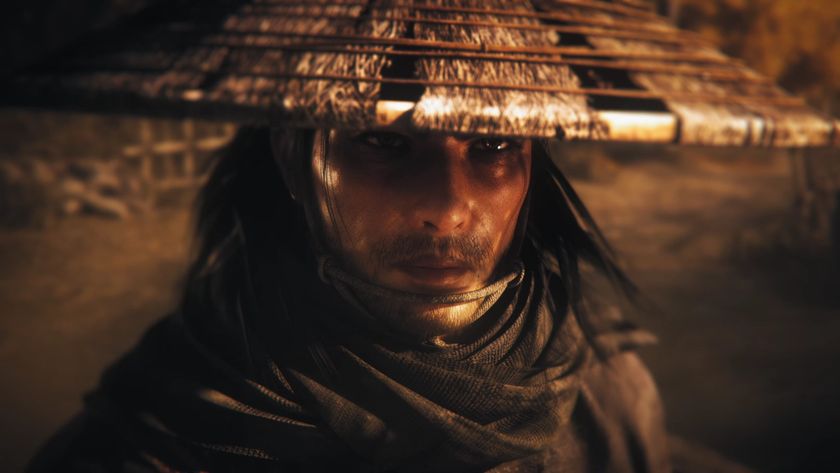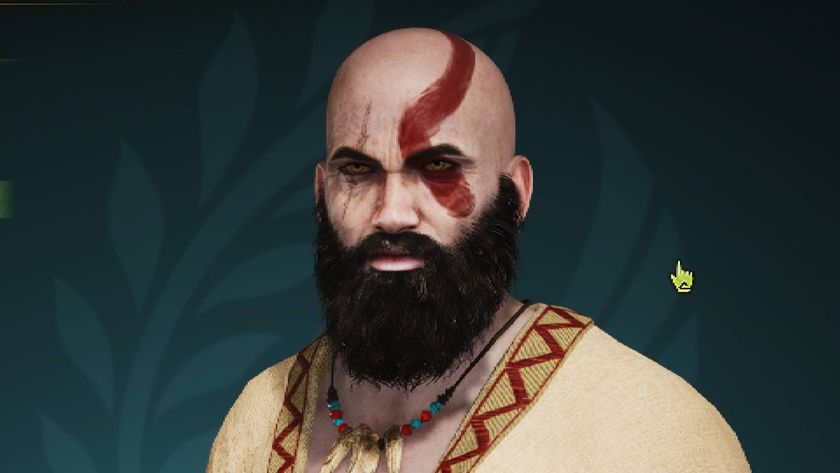The story of the bizarre Mega Man DOS games
How one man made an official, Capcom-licensed Mega Man game by himself.

Mega Man released for the NES in 1987. Three years later, Mega Man released for DOS. If you've heard of it, it's probably through lists of the worst PC ports ever. But it wasn't really a port of Mega Man. The DOS version was an original game which the creators of Mega Man had nothing to do with. And it's a very, very strange game.
The character sprite is an approximation of Mega Man, with big black eyes and an oval-shaped head, as well as highlights to make him look rounded. He matches the poses from the original, but the slight differences turn an icon into a stoned-looking sausage man.
The DOS Mega Man opens with stoned, sausage Mega Man passing through a police checkpoint in what appears to be the start of a different game. And then a leaping sentry dog kills him. If you don't know what to do, the dog will kill you. You can kill the dog, if you somehow connect with a couple of bullets, but the dog will respawn infinitely—and kill you.
The only way to get to the stage select screen is to ignore the dog and run and jump and hope you make it.
This might have all been lost to time, but Internet Archive and My Abandonware now host copies of Mega Man which can be run with DOSBox. Capcom, as far as I can tell, is content to ignore its existence. You certainly won't find it in the Mega Man Legacy Collection, or in the 2009 Udon-published retrospective Mega Man: Official Complete Works. Who, if anyone, holds the rights is unclear—Capcom licensed the character to publisher Hi-Tech Expression, which is out of business. And yet it's as much an official Mega Man game as any other.
It's just that any attempt to play it fills me with regret. Mega Man on DOS is a brutally difficult approximation of Mega Man's NES leaping and blasting that never, ever feels right, especially on a keyboard.
To its credit, Mega Man was made from scratch—no actual NES Mega Man levels or assets are used—and had only one developer: Steve Rozner. I got in touch with Rozner, who's still in the industry, and though I haven't been able to set up an interview yet, he pointed me to a previous interview published in The Untold History of Japanese Game Developers in which he explains how all this happened.
The biggest gaming news, reviews and hardware deals
Keep up to date with the most important stories and the best deals, as picked by the PC Gamer team.
Before Mega Man, Rozner was responsible for the C64 port of Street Fighter. He then developed Pocket Rockets at Riggs International, a company which Rozner says consisted of only him, "an artist and the boss."
The three developers were scooped up by Capcom USA, which planned to form an internal development studio—but that didn't happen. So, while managing external developers, Rozner "just started to make the Mega Man PC game" on his own.
Rozner left Capcom USA, and the publisher agreed to let him release his DOS version of Mega Man when it was finished. Bizarrely, it sounds like that was about the extent of the agreement. No strict guidelines, no stipulations. Imagine, today, a major publisher handing out licenses to ex-employees. It's been a pleasure working with you at Nintendo, as a parting gift, feel free to release the PC Zelda game you've been making.
Rozner had no asset files or assembly code from Capcom Japan or USA to work with—that sort of sharing didn't happen until Mega Man X, which his company Rozner Labs would later port, but even then they had to play the game and reverse engineer the code for the PC verison.
So when it came to the first Mega Man, "I just made whatever I wanted since I loved the Mega Man NES games so much," said Rozner in the Untold History interview.
Because he was developing the game entirely on his own, there are only three bosses: Voltman, Sonicman, and Dynaman. I haven't reached any of them myself, because even when I slow down the game speed in DOSBox, I'm at Rozner's mercy, and he shows none. If the infinitely respawning enemies don't peck me to death, a surprise projectile or electricity trap or disappearing platform finishes the job. Or a frog.
With no music and only bleepy DOS sound effects, Rozner's Mega Man comes across as a tragic character in a dense hell of hopping, flying, shooting pain. The opening sequence with the dog is a sincere warning: turn back now. It doesn't help that many of the backgrounds are busy, tightly-repeating patterns, and that they're populated by similarly-colored enemies.
When I'm not dying, the three stages are charming translations of the original NES game filtered through the technical limitations of DOS and the skills and ideas of someone who had nothing to do with making the NES version. The colors are all nearly right and the tiles are clearly inspired by Mega Man tiles, but flatter—so it's especially odd that Mega Man himself looks rounder. And then there are very different segments: Voltman's stage begins with Mega Man battling parrots on top of power lines while hopping over energy surges.
I was never very good at the original Mega Man games, so I'm not surprised that this somehow-official fan game owns the hell out of me. A player with a better constitution, below, shows how it's done.
After Mega Man, Rozner and his brother, William, went on to create another original Mega Man DOS game, called Mega Man 3. There was never any Mega Man 2 on DOS. This is because, according to Rozner, Capcom USA wanted to reuse the boxart from the NES Mega Man 3, which featured a boss who looked sort of like one of the Rozner-designed bosses.
Mega Man 3 for DOS is stranger still, as it started as a different game, called Eco Man, which featured a character in a hazmat suit exploring non-linear levels on an oil rig and ship. Hi-Tech Expression said it would publish the game if it were reskinned as a Mega Man game. So that's why, in the video below, you see a bizarre, off-model Mega Man swimming animation.
Imagine never playing the NES versions and thinking that this is what Mega Man is. The two original Mega Man DOS games are monuments to the casual, spontaneous industry of the 80s and early 90s, when Japanese companies and their US offshoots worked in loose collaboration (though I've heard this hasn't actually changed much at some companies) and PC ports happened by playing a game from Japan, deciding it's good, and then making something kind of like it. It only seems stranger when you know that the same year Mega Man was released on DOS, John Romero, Tom Hall and John Carmack pitched Nintendo with a far more faithful demo of Super Mario Bros. 3 they'd programmed for DOS.
The Rozners worked on several games through the mid-90s, including an unreleased NES Street Fighter port, and according to William, a never-released SNES game called NFL Heroes. "You traveled through time, like in the film Time Bandits, as a boy or girl, and were helped out along the way by NFL mascots that each had a different power to aid you," says William in the interview. It's a damn shame that game was never released. Steve, if you're reading, please find NFL Heroes and release it as soon as possible. I'll buy it.
The complete interview with Steve and William Rozner can be found in The Untold History of Japanese Game Developers by S.M.G Szczepaniak. An original version of the Mega Man DOS game was listed on Ebay for $130.

Tyler grew up in Silicon Valley during the '80s and '90s, playing games like Zork and Arkanoid on early PCs. He was later captivated by Myst, SimCity, Civilization, Command & Conquer, all the shooters they call "boomer shooters" now, and PS1 classic Bushido Blade (that's right: he had Bleem!). Tyler joined PC Gamer in 2011, and today he's focused on the site's news coverage. His hobbies include amateur boxing and adding to his 1,200-plus hours in Rocket League.















